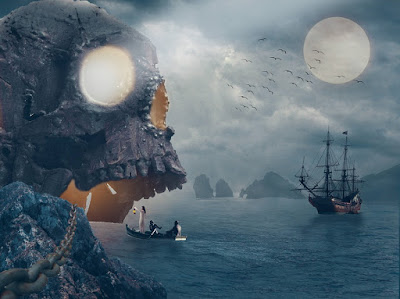Ghost ships and the haunted coast
And yet, for those of us fascinated with things dark and gloomy, beaches are the ideal haunts for finding the inspiration for ghostly tales. That set me thinking about what legends exist about ghosts and beaches. Not haunted ships, and terrifying tales of the Kraken and other sea monsters - for millennia sailors and fishermen and seafarers have told elaborate tales of danger and adventure and supernatural horrors out in the vastness of the ocean.
And of course, since sea travel was once so dangerous, they can be forgiven for allowing their imaginations to run riot...or we can be forgiven for choosing not to quite believe their tales. Even modern stories of suddenly disappearing fishing vessels in notorious waters such as the Bermuda Triangle, or of damaged ships running aground on the Japanese coast, their crew no more than rotting corpses, their cargo swilling about untouched, do little more than have us raise a sceptical eyebrow.
So, pausing in my preparation to head for the beach this afternoon, I decided to look up beach-related ghost stories.
I found - to my joy, because I lived nearby and used to bathe in this part of the Kent coastline regularly - the Goodwin Sands. Of course these are haunted, was my eager thinking. The Goodwin Sands, a ten mile long sand bank at the southern end of the North Sea some few miles off Deal, on the Kent coast, were notoriously dangerous for seafarers, and thousands of ships have perished on this treacherous stretch of sea over the centuries. The locals used to call the Sands "the Great Swallower" as many vessels disappeared here leaving no trace.
It is said that every fifty years, the Goodwin Sands hosts the appearance of a ghost ship, the Lady Lovibund, a three-masted barque that was wrecked on the Sands on 13th February 1748. The Lovibund was on its way to Oporto. On board was the first mate, John Rivers, who was deeply jealous of the ship's master, Simon Reed, who had just been married and whose wedding party travelled on the ship with them. John Rivers was Reed's best man at the wedding but was consumed by unrequited love for Reed's new wife. As the ship approached the Sands, Rivers smashed Reed's skull with a crushing blow and took over the helm. With the wedding party still at their festivities below, Rivers drove the ship into the Goodwin Sands, and the Lovibund went down with the loss of all who sailed in her. Twice a century since, the ghost ship is seen crashing into the sands, silently drowning again.
There's another legend about the Goodwin Sands. Locals also say that a thousand or more years ago, the Sands were a small island called Lomea, which was swept away in the most ferocious of storms in 1099, and all the inhabitants of the island drowned. The English at the time, blamed the Norman conquerors for not repairing and maintaining the sea defences. This allowed the sea to swallow the island which emerges from time to time as the tides and its sands shift. There is no official, documented evidence that Lomea ever existed, although when borings were made to prepare to build a lighthouse on the Sands, a stratum of London clay over a chalk basement was found. This was thought to be the remains of a clay island, and this could be linked to the Roman reference to "Infera Insula" in this area. So it is possible it may have existed.
No-one knows for certain, but local people say that on wild nights, the sounds of church bells tolling and the drowning screaming are still carried inland on the wind...
Two great stories just in that one tiny spot of coastline in Kent. Of course, the cynical among us (myself included) will point to just how useful these legends are in keeping people scared and well away from stretches of coastline where smugglers happen to be making very good trade. Deal was exactly one of those towns that had been a notorious haunt of smugglers since the early eighteenth century. But the writer in me knows full well that there is never any smoke without fire, and never is a story told that does not hold a spark of truth.
Gibraltar's coastline must surely hold its own sea-faring legends and ghosts. The powerful Levanter currents on its eastern coast, its mysterious networks of caves right down to the shoreline and below sea-level, the treacherous twists and turns of the sea as the waters of the Atlantic and Mediterranean mix and greedily suck down many a vessel...surely there are ghost ships and undead smugglers stalking our seas? The point is finding them and then writing those gruesome, ghostly stories...







Comments
Post a Comment